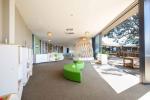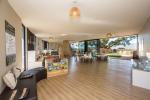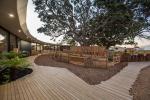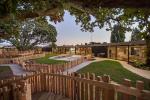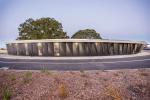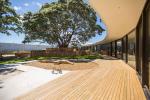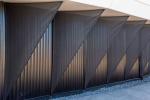Chrysalis Childcare Centre

Two large trees on a commercial site had proved a problem for development but architect Phil Smith decided to make them part of the solution.
Phil, of Collingridge and Smith Architects (UK) Ltd, says the mature protected trees – a pohutukawa and an oak – stand side by side on the site and had driplines that could not be built beneath. As he says, “This makes the site uneconomic for most commercial uses but actually presents a unique and beautiful opportunity for a childcare centre.
“For most developers the trees have been a big problem, but for early childhood they provide a beautiful and symbolic solution. One is an English oak tree, the other a native pohutukawa, both of equal size and stature, standing side by side, their branches touching at the heart of the site. This symbolism forms the basis for the whakapapa of the site and its new use: a bi-cultural - and multicultural - childcare centre.
He adds: “In the traditional Maori view, the trees also represent Tane who separated Rangi and Papa to create the world (of light). The design draws on this by creating a ‘void’ or space around the trees, which separates out the various elements of the new centre and provides a protective enclosure around the root zone. The building represents Papa (Earth Mother) who was locked in a tight embrace with Rangi (Sky Father), and so the graceful curve of the building appears like two arms reaching out to the sky. The elevation form further enhances this effect by keeping a respectful height below the trees, allowing good views of them from the wider environment.”
Sanjesh Lal, of main contractor Keola, says: “The solution to the problem of the trees was to build the childcare centre in a crescent shape with 31 radiating gridlines – the apex is a point between the two trees. This means that there are no right-angled walls in the building; everything points towards the trees. The shape of the building protects the roots of the trees, and the glass is oriented north to allow it to collect as much winter sun as possible under the lowest branches. Overheating in summer will be avoided because the oak tree will be in leaf.”
Phil Smith says further symbolism can be found throughout the design, the most striking being the sail forms around the outer curve of the building. These are based on traditional Maori sail forms but honour all the cultures of New Zealand, all of whom originally made the journey by sailing boats.
“The layered effect of the overlapping sails also recalls traditional carving patterns whilst the curve of the building represents the Koru or unfurled fern frond. They also give a dynamic form to the building when viewed from the road, a constantly changing experience as the viewer moves around the building. The Dimond Rib 50 cladding and the sails subtly interact; the smooth sails, contrasting with the rib of the cladding, to give a layering effect which again recalls Maori carving patterns.”
While the Dimond Rib 50 is on display, the more innovative use of metal roofing is not. Longrun was used to create a “warm roof” system for the centre.
As Phil Smith explains, “The warm roof system utilises metal profile roofing to support rigid PIR insulation onto which the membrane is fixed.
“We could not use metal profile for the roof as the facets could not be flashed (the whole roof consists of facets of 2 degree pitches, set out at a common height from the canopy facing the trees. Also a membrane allows us to fully seal the roof, which is useful due to the extensive leaf fall from the oak tree. The metal profile takes the place of plywood and allows much greater spans to be achieved for the membrane – the metal profile can then be supported on DHS purlins at 1200 centres (instead of timber rafters at 400 centres for ply) yielding a considerable saving in structure and cost.
“The reason for using the warm roof idea was simple – once we knew we had to use membrane, we only ever design them as warm roofs, which is standard practice in the UK as the dew point is moved to the outside of the build so condensation risk is designed out. There is also no need for venting to the roof space, which is also a leak risk due to the amount of penetrations - with butynol every 25-40m2 needs venting.”
Sanjesh Lal says because the roof is both curved and sloping it presented a challenge when it came to the gutters, in terms of the direction of the rainwater flow on a flat roof. He says the design maximised the rainwater flow to extremely wide gutters, large outlets and overflow systems.
He says with the large trees dropping a lot of leaves, especially the oak in autumn, it was an issue for the concealed gutters.
“If the gutters were to block, there’s the risk that water could go inside the building,” Sanjesh says. “Collingridge and Smith designed the gutters so that they were slightly lower at the front than at the building side. This means that any overflow goes over the side of the gutter onto the ground, rather than inside the building.”
Sanjesh says the building is very much in synch with nature: it has solar panels, rainwater is re-used, there is LED lighting, and low VOC materials, paints and adhesives were used during construction. The design makes the most of natural light and ventilation as well as solar gain. During construction, about 70 per cent of waste materials were recycled, and there is an ongoing recycling programme within the childcare centre.
The cladding was pre-cut off site. This meant that there was minimal wastage, the off-cuts could be directly recycled and it saved time on site.
The circular nature of the site creates a circular driveway around the building. This makes drop-off and collection of children safer, thanks to a one-way traffic flow around the building.
Sanjesh says the centre features Pacifica motifs due to the fact that 68 per cent of school children in the surrounding schools are of Pacific ethnicity. There’s a replica of a traditional Pacific village in the garden, complete with Maori wharenuis, Fijian bures, and Samoan fales. The nature theme continues, with an edible garden, to teach children about food and nature.
Inside, the centre is symmetrically laid out with a central reception area, with kitchen behind. On either side are almost identical mirror image layouts of classrooms, sleep rooms, toilets and changing facilities, with storerooms at the tips of the tapering arms so there is no dead space.
The reception area is designed to resemble the inside of a chrysalis – and there are also floor to ceiling cocoon walk-in play structures. The chrysalis theme is important; not only is it the name of the childcare centre, but it also represents the owners’ approach to childcare. They say: “A chrysalis is a protected stage of development, where care is first and foremost, followed by development and transformations that are calm and unhurried, yet filled with wonder and amazement.”

